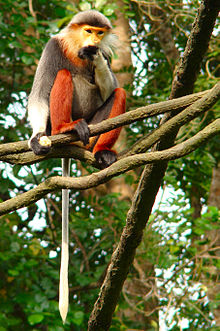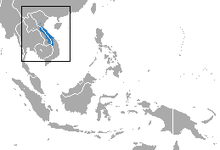Red-shanked douc
| Red-shanked douc | |
|---|---|
 |
|
| Scientific classification | |
| Kingdom: | Animalia |
| Phylum: | Chordata |
| Class: | Mammalia |
| Order: | Primates |
| Family: | Cercopithecidae |
| Genus: | Pygathrix |
| Species: | P. nemaeus |
| Binomial name | |
|
Pygathrix nemaeus (Linnaeus, 1771) |
|
 |
|
| Red-shanked douc range | |
The red-shanked douc (Pygathrix nemaeus) is a species of Old World monkey, among the most colourful of all primates. This monkey is sometimes called the "costumed ape" for its extravagant appearance. From its knees to its ankles it sports maroon-red "stockings", and it appears to wear white forearm length gloves. Its attire is finished with black hands and feet. The golden face is framed by a white ruff, which is considerably fluffier in males. The eyelids are a soft powder blue. The tail is white with a triangle of white hair at the base. Males of all ages have a white spot on both sides of the corners of the rump patch, and red and white genitals.
The word "douc" (pronounced 'dook') is a Vietnamese word meaning "monkey". The douc is an arboreal and diurnal monkey that eats and sleeps in the trees of the forest.
Like other doucs, the red-shanked douc is a long, slender monkey. The male has an average head and body length of 61 cm (24 in), and the female averages 54.5 cm (21.5 in) long, with a tail that measures 55.8–76.2 cm (22.0–30.0 in) long. Males weigh on average 11 kg (24 lb), and females 8.44 kilograms (18.6 lb). There is a slight difference in rump markings between genders: the male has round white spots above the triangle of white on its rump, while the female does not.
All doucs are native to Southeast Asia, specifically the countries Cambodia, China, Laos and Vietnam. The red-shanked douc is thought to be found only in north and central Vietnam and Laos. Before 1967, the douc was completely unstudied. Doucs are found in a variety of habitats: from lowland to mountainous terrain up to 2,000 m (6,600 feet), deciduous, primary and secondary rainforests, in the mid to upper levels of the canopy.
Doucs are, like all monkeys, social animals. They live in groups with an average size of 4 to 15, but groups of up to 50 have been recorded. A group usually consists of one or more males and approximately two females per male. Both males and females have their own hierarchies and males are dominant to females. Both males and females will eventually leave the group they were born into.
...
Wikipedia

